
- Accueil
- Authenticité
- Hauteur
- Matière
- Origine
- Afrique (51)
- Allemagne (24)
- Amériques (16)
- Angleterre (37)
- Asie (225)
- Belgique (18)
- Chine (32)
- Egypte Ou Syrie (14)
- Espagne (38)
- Europe (25)
- France (3026)
- France - Alsace (46)
- Inconnue (92)
- Italie (73)
- Japon (24)
- Moyen-orient (60)
- Pays-bas (17)
- Perse / Persia (24)
- Russie (17)
- Suisse (25)
- Autre (1159)
- Pays D'origine
- Sous-type
Sgabello Escabelle Italie XVII XVIII eme siecle

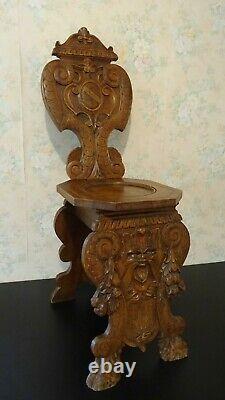
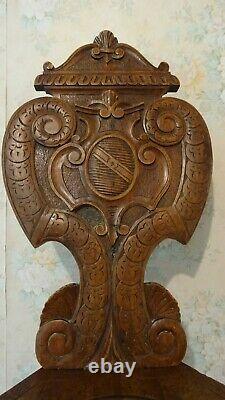
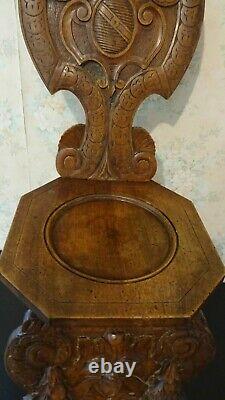
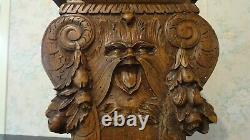
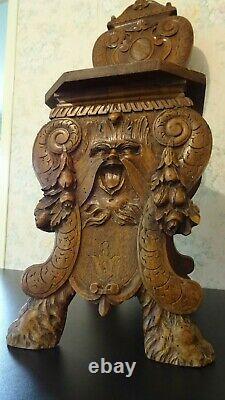
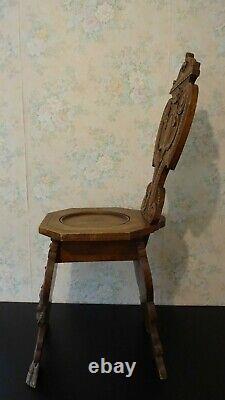
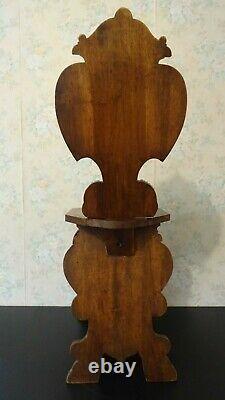


Magnifique Sgabello Italie XVII - XVIII siècle. Ce Sgabello est italien et date du 17ème ou 18ème siècle.
On remarque la présence de lis stylisés; le lys de Florence "il Giglio" étant le blason de la ville depuis le XIe siècle, c'est un raid florentin. En noyer, et entièrement sculpté, cette antiquité ressemble beaucoup plus à une sculpture et à une uvre d'art qu'à une chaise et un meuble. Le terme «sgabello» ou «sgabelli» vient de «scanno» qui signifie selles. Ces chaises étaient maintenues contre les murs. Cet usage explique, vu de côté, la sobriété des lignes.
Les surfaces profondément sculptées nous rappellent l'époque où, la nuit, l'intérieur des maisons n'était éclairé que par la lumière naturelle émise par un feu ardent ou des bougies allumées. Ce type de lumière projette des ombres dramatiques et se prête magnifiquement à l'art sculptural. Les motifs, placés symétriquement, les volutes, les fioritures, coexistent dans un équilibre général harmonieux, rappelant ainsi le meilleur du design italien. Ces chaises typiques ont été historiquement trouvées, dans les palais italiens d'importantes familles aristocratiques, et plus précisément dans les halls d'entrée. Emblème d'une famille puissante avec un intérieur bien meublé, c'est à la fois une démonstration de richesse et un court lieu de repos.
Ce Sgabello est tout simplement sublime à bien des égards, et surtout magnifiquement harmonieux. Le socle comporte deux supports à volutes, avec des feuilles d'acanthe et des fleurs, symbole de l'amour éternel. Le tout sur les pieds d'une chimère.
Avec frise en haut et lis de Florence en bas, le cadre est ainsi donné au mascaron. Ce masque, figure humaine effrayante, a une fonction apotropaïque: il éloigne les mauvais esprits pour qu'ils n'entrent pas dans la maison.
L'assise, sobre, ajourée d'un cercle, est octogonale. Il est à noter qu'il s'agit de la forme classique, allant de la fin de la Renaissance au début de l'art baroque, c'est-à-dire au début du XVIIe siècle.Le dossier haut est amovible. Deux nouveaux supports à volutes sont là, fermés sur eux-mêmes en bas. Rappel de la frise du haut, qui cette fois donne le cadre à un cartouche aux armoiries de la famille. Ces armoiries ne sont pas identifiées. Sur le fronton: lys de Florence sur une couronne stylisée, symbolisant la puissance et la victoire.
Magnificent Sgabello Italy XVII - XVIII century. This Sgabello is Italian and dates from the 17th or 18th century. We notice the presence of stylized lilies; the lily of Florence "il Giglio" being the coat of arms of the city since the eleventh century, it is a Florentine raid. In walnut, and entirely carved, this antique is much more like a sculpture and a work of art than a chair and a piece of furniture.
The term "sgabello" or "sgabelli" comes from "scanno" which means stool. These chairs were held against the walls. This use explains, when seen from the side, the sobriety of the lines. The deeply sculpted surfaces remind us of the time, when at night, the interior of the houses was lit only by natural light emitted by a blazing fire or burning candles.
This type of light casts dramatic shadows, and lends itself beautifully to sculptural art. The patterns, symmetrically placed, the volutes, the flourishes, coexist in a harmonious general balance, thus reminding us of the best of Italian design. These typical chairs were historically found, in the Italian palaces of important aristocratic families, and more precisely in the entrance halls. The emblem of a powerful family with a well-furnished interior, it is both a demonstration of wealth and a short resting place. This Sgabello is simply sublime in many ways, and above all beautifully harmonious.
The base features two scrolled supports, with acanthus leaves and flowers, a symbol of eternal love. All on the feet of a chimera.
With frieze at the top and lily of Florence at the bottom, the frame is thus given to the mascaron. This mask, a frightening human figure, has an apotropaic function: it keeps evil spirits away so that they do not enter the house. The seat, sober, openwork of a circle, is octagonal. It should be noted that this is the classical form, ranging from the end of the Renaissance to the beginning of Baroque art, i. The beginning of the 17th century.
The high backrest is removable; it is securely mortised in the seat and pegged under the seat. Two new scrolled supports are there, closed on themselves at the bottom. Reminder of the frieze at the top, which this time gives the frame to a cartouche with the family coat of arms.
These coats of arms are not identified. On the pediment: Florence lily on a stylized crown, symbolizing power and victory. L'item "Sgabello Escabelle Italie XVII XVIII eme siecle" est en vente depuis le dimanche 25 octobre 2020.
Il est dans la catégorie "Art, antiquités\Objets du XIXe et avant". Le vendeur est "ptiteflower17" et est localisé à/en GOULLES. Cet article peut être livré partout dans le monde.
- Origine: Italie
- Sous-type: Non-spécifié
- Objet modifié: Non
- Matière: Bois
- Type: Objet d'art populaire
- Authenticité: Original
- Style: Renaissance

